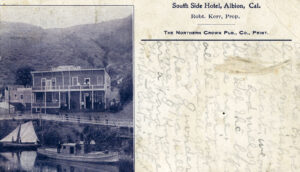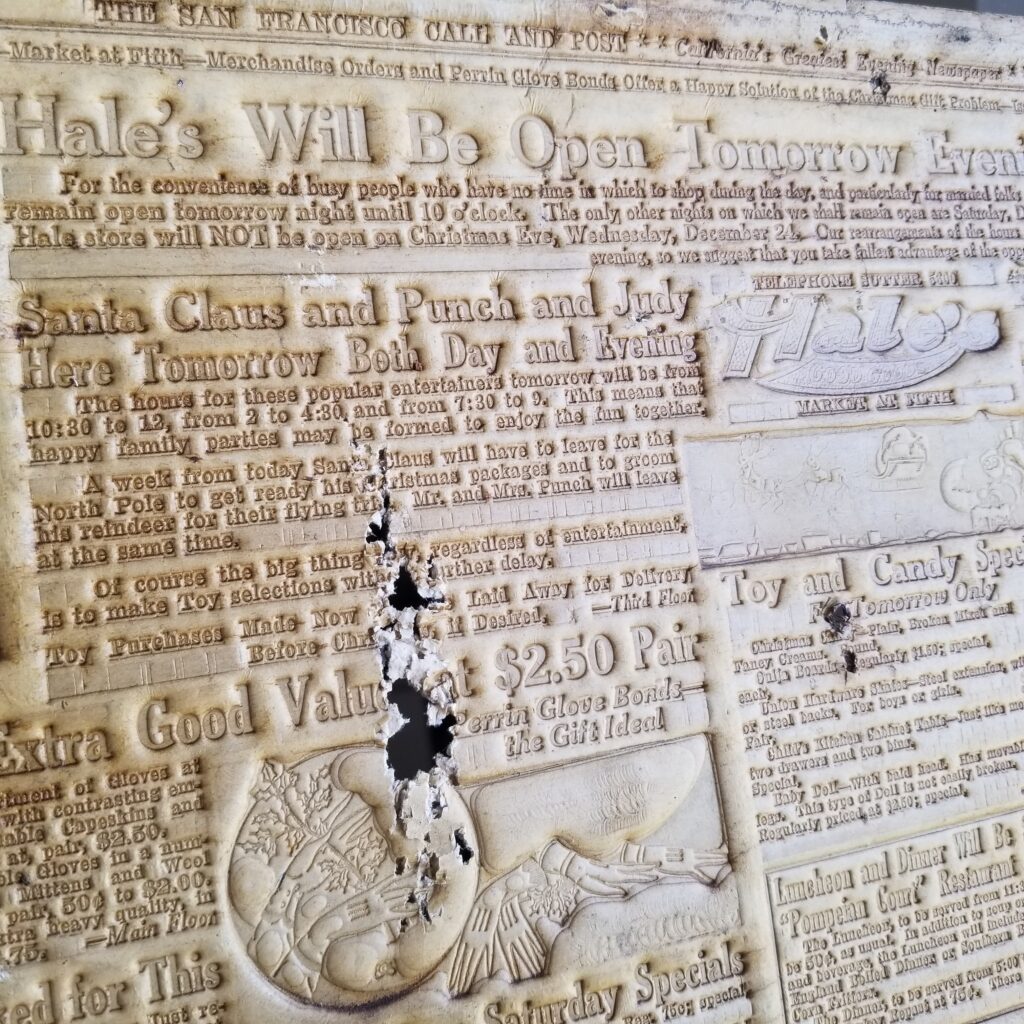The Kelley House has two postcards with photographs of the now gone Southside Hotel in Albion. Until recently, that’s about all we had to remember the once popular complex of buildings that Bob Kerr and Joe Rushing started in 1903.

The hotel was located on the Coast Road near the draw bridge which once carried traffic over the Albion River, and incorporated for its dining room and kitchen an existing building once occupied by Jon Newgard’s old store.The main part of the hotel, however, was entirely new. Two stories high and 40 x 80 feet in size, it was lighted by electricity and up-to-date in every way.
It was an immediate hit, and by the end of its first year, there were about 50 boarders occupying the hotel. A Beacon correspondent quipped, “The South Side Hotel is doing a ‘Rushing’ business and they know how to take ‘Kerr’ of their guests.”
Kerr & Rushing then acquired the Albion Lumber Company’s feed stable “where we will always be found ready to care for all stock entrusted to us in first-class style.” Maps of 1909 show many wagon sheds and hay storage buildings just north of the hotel.
The Southside was a lively and well-connected hostelry. In addition to accommodating horses, the hotel was convenient to the stages going up and down the Coast Road (practically at their threshold), or sea travel aboard the “Pomo,” which steamed regularly up from San Francisco to Albion’s long and commodious wharf.
Building on their success, the two men hired Peter Carlson in 1904 to design and build a dance hall. With this addition to their business complex, the Southside became a hub for Albion’s social life, hosting well-attended dances and celebrations that started one day and ended at dawn the next.
Then in 1905, the two-year partnership was over, with Joe Rushing “retiring” and Bob Kerr continuing the management as sole proprietor. One month later, an ominous newspaper report stated that Rushing had unsuccessfully tried to buy out Kerr, but then purchased the Windsor Hotel in Fort Bragg instead, much to the relief of Bob Kerr’s friends. At this point, Bob’s brother James entered the picture and advertisements and notices from then on refer to “The Kerr Bros.” operating the Southside.
Together, Bob and James continued to make improvements, adding two bathtubs to the barber shop and purchasing a pianoette to grace the hotel lobby with lovely music while people played card games and enjoyed drinks served up by mixologist Davy Crockett behind the bar.
Unfortunately, Bob died in 1910 after an operation in San Francisco at the age of 59, but James continued at the Southside until he sold out and moved away. We don’t know exactly when the hotel shut down, but events and marriages were celebrated there until at least 1928.
Last month, the Kelley House received an unusual item. It was a large sheet of thick, creamy white papery material that looked like a pressed page of a newspaper, dated 1913. As soon as I saw it, I recognized it as a matrice. But only because I had read about it here, in connection with the Southside Hotel:
“The new hall of Kerr & Rushing, on the south side, is a splendid one-story structure 40 x 60 feet and is laid with one of the finest floors on the coast and was dedicated by a free ball and supper. The hall was tested to its fullest capacity on the night of the launching of the ‘Sotoyome.’ Messrs. Kerr & Rushing gave a famous ball and banquet which caused their praises to be sung all up and down the coast. The hall is tastily finished in tinted burlap and wainscotted with stained papier mache matrices from the San Francisco Bulletin and presents a striking and pleasing effect. (Mendocino Beacon, December 24, 1904, p.1)
A little research revealed that these paper matrices were also called flongs. First developed in France for book printing in 1848, flongs were temporary negative moulds made of a forme of set type, in order to cast a metal stereotype that can be used in a rotary press, or in letterpress printing after the type has been broken down for re-use. Once they had served their intended purpose, they were usually burned, or re-purposed to insulate and decorate interior walls and ceilings, a little like wallpaper tiles.

To learn more about this fascinating printing process, called stereotyping, check out Wikipedia’s illustrated entry on the flong’s now-gone history – and remember the Southside Hotel.
The Kelley House Museum and Research Center is open in June on Fridays, Saturdays, and Sundays from 11am to 3 pm. Walking tours are available at 10:30 every Saturday and Sunday and by appointment. Visit our website at www.kelleyhousemuseum.org for the latest news and activities or contact us at info@kelleyhousemuseum.org.